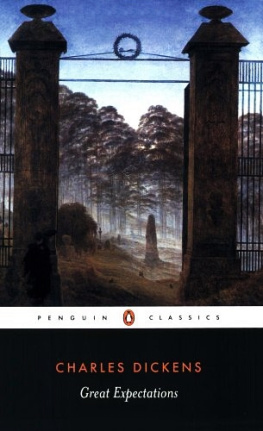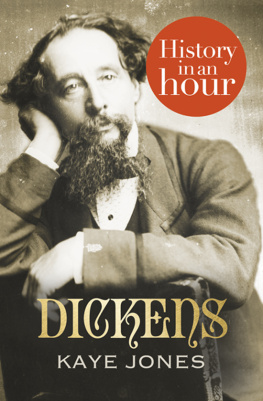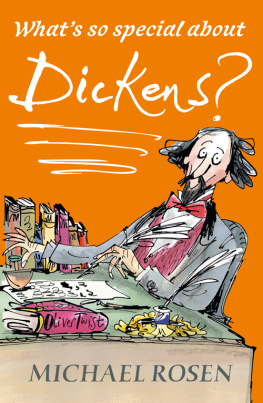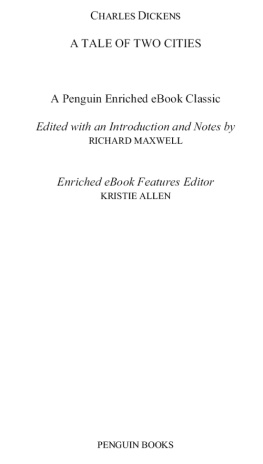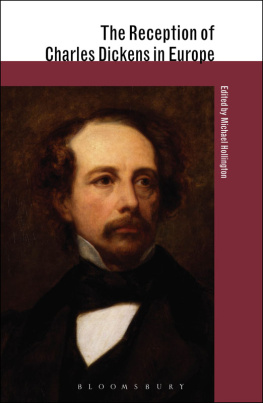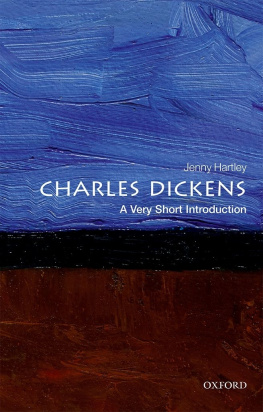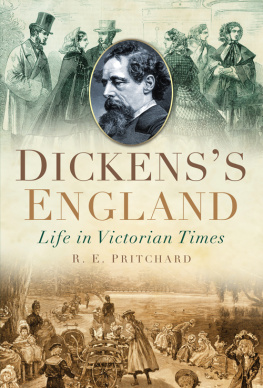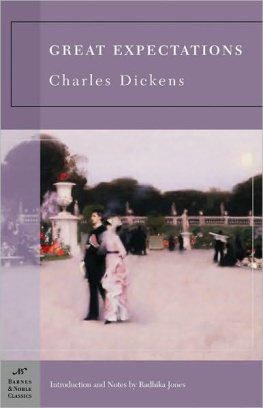CHARLES DICKENS
Born on February 7, 1812, Charles Dickens was the second of eight children in a family burdened with financial troubles. Despite his deprived beginnings, he became the best-selling writer of his time.
In 1824, young Charles was withdrawn from school and forced to work at a boot-blacking factory when his improvident fatherin fact, his entire family, except for himwas sent to debtors prison, where they remained for three months. Once they were released, Charles attended a private school for three years. The young man then became a solicitors clerk, mastered shorthand, and before long was employed as a Parliamentary reporter. When he was in his early twenties, Dickens began to publish stories and sketches of London life in a variety of periodicals.
It was the publication of The Pickwick Papers (18361837) that catapulted the twenty-five-year-old author to national renown. Dickens wrote with unequaled speed and often worked on several novels at a time, publishing them first in monthly installments and then as books. His early novels Oliver Twist (1837-1838), Nicholas Nickleby (1838-1839), The Old Curiosity Shop (1840-1841), and A Christmas Carol (1843) solidified his enormous, ongoing popularity. When Dickens was in his late thirties, his social criticism became biting, his humor dark, and his view of poverty darker still. David Copperfield (1849-1850), Bleak House (1852-1853), Hard Times (1854), A Tale of Two Cities (1859), Great Expectations (1860-1861), and Our Mutual Friend (1864-1865) are the great works of his masterful and prolific later period.
In 1858 Dickenss twenty-three-year marriage to Catherine Hogarth dissolved when he fell in love with Ellen Ternan, a young actress. The last years of his life were filled with intense activity: writing, managing amateur theatricals, and undertaking several reading tours that reinforced the publics favorable view of his work but took an enormous toll on his health. Working feverishly to the last, Dickens collapsed and died on June 9, 1870, leaving The Mystery of Edwin Drood uncompleted.
THE ORIGINAL ENDING TO GREAT EXPECTATIONS
In the third volume of his biography of Dickens, published thirteen years after Great Expectations, John Forster revealed that the novels ending as it had appeared in print was in fact not its original one. The author had been persuaded by his friend Edward Bulwer-Lytton, a novelist and critic, to alter the final scene while the text was still in proofs, granting Pip a slightly happierthough certainly still ambiguousreunion with Estella. Dickens wrote to Forster in July 1861: You will be surprised to hear that I have changed the end of Great Expectations from and after Pips return to Joes, and finding his little likeness there. Bulwer, who has been, as I think you know, extraordinarily taken by the book, so strongly urged it upon me, after reading the proofs, and supported his view with such good reasons, that I resolved to make the change.... I have put in as pretty a little piece of writing as I could, and I have no doubt the story will be more acceptable through the alteration.
Forster supplied Dickenss original ending in a footnote, explaining by way of preface that what we know as the final chapter break in Great Expectations was absent (the paragraph describing Herberts business led directly to that regarding the last time Pip had seen Joe), and that the eight years since Pip and Joe had met were shortened from eleven years in the first version. (Inadvertently, Forster created confusion by reversing those numbers; it is the published text that reads eleven years.) The original ending was printed in Forsters note as a single paragraph, but as Edgar Rosenberg points out in his article Last Words on Great Expectations, it appears as four paragraphs in the proofs, a more reliable indicator of Dickenss intent before he changed the text altogether. Pips line O noI think not, Biddy initially read I am sure and certain, Biddy, and the scene continued as follows: It was two years more, before I saw herself. I had heard of her as leading a most unhappy life, and as being separated from her husband who had used her with great cruelty, and who had become quite renowned as a compound of pride, brutality, and meanness. I had heard of the death of her husband (from an accident consequent on ill-treating a horse), and of her being married again to a Shropshire doctor, who, against his interest, had once very manfully interposed, on an occasion when he was in professional attendance on Mr. Drummle, and had wit nessed some outrageous treatment of her. I had heard that the Shropshire doctor was not rich, and that they lived on her own personal fortune.
I was in England againin London, and walking along Piccadilly with little Pipwhen a servant came running after me to ask would I step back to a lady in a carriage who wished to speak to me. It was a little pony carriage, which the lady was driving; and the lady and I looked sadly enough on one another.
I am greatly changed, I know; but I thought you would like to shake hands with Estella too, Pip. Lift up that pretty child and let me kiss it! (She supposed the child, I think, to be my child.) I was very glad afterwards to have had the interview; for in her face and in her voice, and in her touch, she gave me the assurance, that suffering had been stronger than Miss Havishams teaching, and had given her a heart to understand what my heart used to be.
INSPIRED BY GREAT EXPECTATIONS
Film Adaptations
Part of the attraction of any Dickens novel is the way in which the author imbues scenes and situations with vibrant, almost palpable life and realism. Part of Dickenss strength lies in his ability to translate true-to-life detail into poignant, inner landscapes, to indelibly etch his world onto the imaginations of his readers. This may be why film versions of his novels are so successfulthe audience experiences an eerie frisson of dj vu.
David Leans 1946 adaptation of Great Expectations has been included on several lists of the greatest films of all time and is noteworthy for its determined faithfulness to the novel. Now better known for his later epics Lawrence of Arabia (1962) and Doctor Zhivago (1965), Lean uses Dickenss story to interweave myriad strands of comedy, social observation, and psychological investigation. Early in the film, his cinematic techniques echo the darker broodings of the novel: Both Pips terrifying encounter with the convict Magwitch and his meeting with Miss Havisham are shot like scenes in a horror film, and Miss Havishams house, overrun with cobwebs, is pointedly reminiscent of a haunted house. As Pip attempts to transform himself into a gentleman, the film becomes more buoyant, and, like Dickens himself, Lean loads the dramatic conclusion, keeping it appropriately sentimental.
David Leans Great Expectations won Academy Awards for Best Cinematography and Art Direction, for a magnificently recreated old London, and was also nominated for Best Picture, Best Director, and Best Screen-play.
Perhaps it is precisely because Leans film flourished in its faithfulness to the novel that critics were less impressed with director Alfonso Cuarns 1998 version of Great Expectations, which made a point of departing from Dickens. Cuarn updates virtually everything in the book, including the setting, exchanging nineteenth-century England for modern-day America and London for New York. Finn, whose name has been changed from Pip and who is played by the boyish Ethan Hawke, possesses a believable and endearing naivete. Upon acquiring his mysterious benefactor, Finn struggles to become an artist instead of a gentleman; he uses his past as material for his paintings rather than trying to climb out of his class. Estella, played by a waifish Gwyneth Paltrow, remains more or less unchanged from the unmercifully taunting and teasing character Dickens created. Stunningly photographed, the Cuarn films bold interpretation provides a striking complement to Leans classic.

